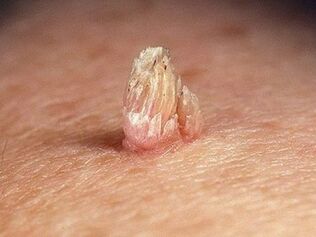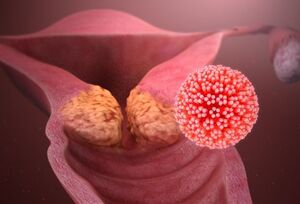
Human papillomavirus (HPV) is a collective name for a group of DNA viruses transmitted from person to person and causing the development of benign neoplasms - papillomas. Some varieties are oncogenic (that is, they increase the risk of malignant tumors). HPV is most commonly associated with cervical cancer, which kills thousands of women worldwide each year. However, these viruses also affect the development of other cancers: not only in women, but also in men.
HPV does not manifest itself as symptoms for a long time: patients are usually aware of this only when precancerous conditions or cancer arise. HPV is a threat to patients of any gender and age, including young children. Even so, their main "target audience" is people aged 15 to 30: they are sexually active, not always thinking about precautions and, in most cases, HPV is transmitted sexually.
To prevent the impact of the virus on the body from going so far, it is recommended to regularly check your health status: to exclude the pathologies that it can cause. There are also tests for HPV to detect the presence of oncogenic strains. Take care of your health right now: make an appointment at the Otradnoye Polyclinic and go to a doctor's appointment without having to wait in lines or adapt to an inconvenient time for you
What is HPV
Human papillomaviruses, which enter the body through microtrauma of the skin, are introduced into the cells of the basal layer of the epithelium. HPV can exist in any layer of the epidermis. However, its reproduction occurs exclusively in the basal layer.
The development of the virus occurs in 2 steps:
- Reproductive - the virus enters the cell without affecting its chromosomes and multiplies.
- Integrative - HPV is introduced into the genome of an infected cell.
It is during the second stage that the virus transforms cells. They begin to actively divide, and tumor-like formations - papillomas - appear. They are papillary growths that protrude above the surface of the skin (that's why they are called: papilloma - from the Latin papilla - nipple and Greek oma - tumor). The second stage does not always occur. The virus, being in the first stage of development, is capable of regressing (leaving the body). However, even if the patient has no pathological changes, he has HPV and can infect other people.
The incubation period can last from 3 weeks to a year. On average, it's 3 months. In some cases, non-genital forms of papillomas appear first, and then neoplasms appear on the genitals.

In most cases, the body faces the virus in 2 years. However, reinfection can occur - with the same or a different strain. In addition, papillomas or other cutaneous manifestations are able to regress after 6-8 months (gradually decrease and disappear later). This happens when the immune system suppresses the virus and "survives" from the cells.
The HPV virus most commonly affects the skin and mucous membranes:
- Anogenital area.
- Upper respiratory tract.
- Oral cavity.
- Bronchus.
- Conjunctives.
- Straight.
- Esophagus.
Types of HPV
The first human papilloma virus (HPV) was isolated in 1971. And scientist Harald zur Hausen was able to identify and prove the connection between HPV and cervical cancer. He subsequently received the Nobel Prize for his discoveries.
About 600 different strains of HPV are known today. Some cause warts, others - genital warts and others - papillomas. There are also types of HPV that affect the development of cancerous tumors. They are called oncogenic. Fortunately, there are not many of them. They can have low, medium or high oncogenic potential:
- Strains 6, 11, 40, 42, 43, 44, 54, 61, 70, 72, 81 are characterized by low oncogenicity.
- Average oncogenicity in types 26, 31, 33, 35, 51, 52, 53, 58, 66.
- High oncogenic potential in strains 16, 18, 39, 45, 56, 59, 68, 73, 82.
Cervical cancer is mainly caused by types 16 and 18.
Help!The presence of a type of oncogenic HPV in the body does not mean that a person is "sentenced" to cancer. The presence of the virus increases the risk of developing cancer, but it is not the only cause of its occurrence.If a patient has an oncogenic HPV strain, they just need to monitor their health closely and have preventive tests regularly. If necessary, the doctor will prescribe the appropriate therapy for him.
The reproductive system of women and men is capable of infecting about 40 types of papillomavirus. The result of its activity is not only cancer, but also genital warts or condyloma.
Help!Cancerous tumors develop slowly: within 5-30 years after papillomavirus infection. They are preceded by precancerous conditions (benign neoplasms that can degenerate into malignant ones). That is why it is so important to have preventive exams regularly. And precancerous conditions, and even cancer in the early stages, are perfectly treatable, and dangerous consequences can be avoided.
HPV transmission paths
The main "condition" of infection is the presence of micro-damages (wounds, cracks, scratches) on the skin or mucous membranes. They are the "doors" of HPV.
In most cases, virus transmission occurs when the skin or mucous membranes of two people come into contact. Therefore, the main route of papillomaviruses is sexual contact. In addition, the use of condoms does not exclude the possibility of infection. The virus can be transmitted through oral sex, during which contraception is not always used. In addition, the condom does not cover the entire surface of the penis and is usually placed in the middle of intercourse. HPV can also be contracted by kissing.
HPV can also be transmitted:
- From mother to child as the baby passes through the birth canal.
- At home: when using other people's hygiene products (towels, toothbrushes, shaving accessories).
- In public places: saunas, gyms, swimming pools.
Help!The survival period for papillomaviruses in the external environment is short. Therefore, the risk of domestic infection, although it exists, is much less than that of sexual contact.
Autoinfection is also possible: transferring the virus from one part of the body to another during epilation, scratching the skin, biting nails.
Infection by contact with a virus does not occur in all cases. The following factors increase the risk:
- Reduced immunity.
- Bad habits: smoking, alcohol abuse.
- Stress.
- Sexually transmitted infections.
- Diseases of the urinary system.
- Injuries to the skin and mucous membranes.
- Immunodeficiency states.
- Prolonged use of hormonal contraceptives.
Help!HPV oncogenic strains are more dangerous for women than for men, as they are infected with them more often.
HPV: symptoms
Papillomaviruses are capable of showing absolutely no symptoms for a long time. Usually, the patient learns of the presence of HPV with the development of its consequences: the appearance of warts, papillomas, genital warts. In some cases, the following signs may indicate the presence of a virus:
- Redness, skin growth (most often in the genital area);
- Itching.
- Pain and other discomfort during or after intercourse.
What diseases can HPV cause?
Papillomaviruses, in the first place, cause the growth of papillomas, warts and genital warts in patients of both sexes. All of the above cancers can occur anywhere on the body. However, most of the time they affect the genitals and the anal area. In women, they occur in the vulva, cervix and vagina. In men - the scrotum, the head of the penis, the foreskin. In patients of both sexes, neoplasms usually appear in the anus.
In addition, warts usually appear on the soles of the feet, larynx and vocal cords. Papillomas (skin-colored papillary formations) do not have a "favorite spot" - they can appear on the trunk, neck, face, arms and legs. In children and adolescents, flat warts are more common (also called juvenile or juvenile). They are small dark neoplasms (3-5 mm) that protrude slightly above the surface of the skin. Most of the time, they occur on the back of the hands, face, legs.

As for cancer, most patients are associated with HPV, primarily with cervical cancer. In fact, this pathology is very common in our time. However, in women, HPV also frequently causes cancer of the vagina and vulva (65-70% of cases), in men - cancer of the penis (50% of cases). Also in women and men, papillomaviruses can contribute to the occurrence of malignant tumors:
- straight;
- oral cavity;
- larynx.
In children, HPV, as a rule, is manifested by the growth of papillomas in the context of a decrease in immunity due to previous diseases, usually viral or bacterial infections. In addition, papillomaviruses infect young patients who suffer from allergic reactions or frequent colds.
HPV and pregnancy
Papillomaviruses negatively affect female fertility. If present, the likelihood of pregnancy is reduced by half, as HPV can interfere with the implantation of a fertilized egg. If the partner is also infected with the virus (which occurs in 65-70% of cases), the possibility of conception is further reduced. HPV has a negative effect on sperm motility.
When pregnancy occurs, the papillomavirus increases the risk of developing:
- Small or polyhydramnios.
- Chronic placental insufficiency.
- HPV can also cause miscarriage.
Therefore, pregnant women receive therapy with preservation drugs, which can significantly reduce all of the above risks.
When a child passes through the birth canal, there is a risk of infection. Therefore, women with HPV are preferable to giving birth by cesarean section - the risk of transmitting the virus is reduced by 5 times.
Changes in the hormonal background cause the rapid growth of genital warts. They can grow together, which can cause difficulties in urinating and defecating, delivering unpleasant sensations when walking, bleeding. During delivery, neoplasms are easily injured. They can also make it difficult for the baby to pass through the birth canal. To prevent all of this, genital warts are treated early in pregnancy. Methods such as cryodestruction, laser surgery, etc. they're used.
Diagnosis

To diagnose HPV, they first see a doctor. Depending on the manifestations of the virus, it will refer the patient to diagnostic studies and to a restricted specialist (gynecologist, urologist, dermatologist, oncologist, proctologist, etc. ).
Women and men can be assigned to exams such as:
- ELISA blood test - according to the results, it is impossible to determine the concentration and oncogenicity of the virus, but it is possible to detect antibodies against it, the method is ideal for early diagnosis, when symptoms have not yetappeared.
- Diagnosis by PCR - allows to identify the HPV DNA, that is, allows to know exactly whether or not there is a virus in the body; blood, saliva, secretion of Organs genitals, etc. are taken for analysis.
- Digene test - allows to assess the degree of oncogenicity of a strain, to establish the amount of viruses in the body; Biomaterial is a piece of tissue, scraped from the cervical canal, vagina or urethra.
Women are prescribed the following types of exam:
- Cytological examination (PAP test) - examination of a smear of the vagina under a microscope to identify cells altered by the virus.
- Colposcopy - examination of the cervix with a colposcope device, this procedure is assigned to the patient if abnormal cells are found according to the results of the cytological examination.
Treatment
There is no specific treatment for HPV (that is, with the aim of destroying it). However, you can take steps to suppress virus activity and increase the likelihood of self-healing. The patient is prescribed:
- Vitamins.
- Immunomodulators.
- Antiviral drugs.
Symptomatic treatment is also performed - removal of neoplasms. In no case should you try to treat condyloma, papillomas and warts with folk remedies. There is a risk of causing the development of a secondary infection or the degeneration of a benign to malignant tumor.
The following methods are used to eliminate neoplasms:
- Scalpel removal.
- Free-destruction (freezing with liquid nitrogen).
- Removal with a radio knife.
- Laser removal.
- Electrocoagulation.
The method is chosen by the doctor depending on the nature and location of the neoplasia, as well as the condition of the patient's body.
Prevention

Preventive methods include maintaining a healthy lifestyle and strengthening regular immunity with the help of a complete and varied diet, moderate physical activity and quality rest. It is important to follow personal hygiene rules, not to use other people's accessories. To avoid the risk of infection, you should avoid casual sex and use barrier contraceptives.
Also today, there is the possibility of vaccination against some highly oncogenic HPV strains. Vaccination is recommended between 9 and 26 years (the ideal age is 11-12 years). Women can be vaccinated after 26 years, but only if the gynecologist believes there is evidence. It should be borne in mind that vaccination does not cure a virus already present in the body, but it does prevent infection by some of its especially dangerous types.























